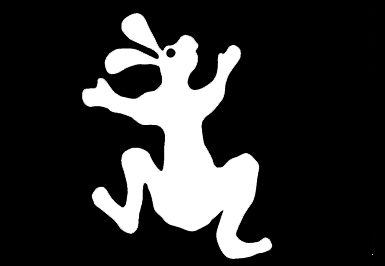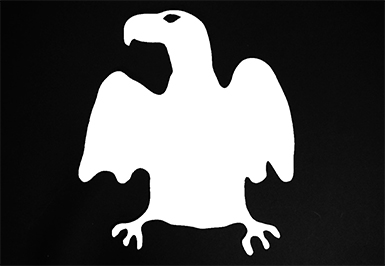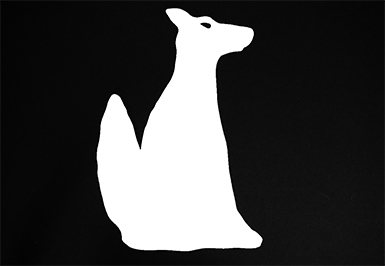Clan Animals & the Woodland Style
Inspired by the art of Gordon M. Coons
Time Required: Two 55-minute class periods
Lesson Overview: Students will explore the meaning of clan animals in Ojibwe culture and Woodlands art and create an artwork inspired by the art of Gordon M. Coons.
ideas to suit your classroom needs.
Students will be able to describe the Woodland art style as it relates to the Ojibwe clan system.
Students will produce a Woodland-style drawing influenced by their study of Ojibwe clan animals and the art of Gordon M. Coons using web resources and stencils designed by Coons.
Note to Educator: Gordon Coons is available to be an artist-in-residence in the Twin Cities schools. For more information and to request a residency, visit the artist’s website.
Drawing paper (preferably 11” × 17”) Colored pencils, crayons, or markers Stencils made from templates included in this lesson.
Images of artwork by Gordon M. Coons featured on his website.
-
K-3: 0.1.1.5.1
Benchmark: Identify the elements of visual art including color, line, shape, texture, and space.
K-3: 0.1.3.5.1
Benchmark: Identify the characteristics of visual artworks from a variety of cultures, including the contributions of Minnesota American Indian tribes and communities.
K-3: 0.2.1.5.1
Benchmark: Create original two- and three-dimensional artworks to express ideas, experiences, or stories.
4-5: 4.1.1.5.2
Benchmark: Describe how the principles of visual art such as repetition, pattern, emphasis, contrast, and balance are used in the creation, presentation, or response to visual artworks.
4-5: 4.1.3.5.1
Benchmark: Describe the personal, social, cultural, or historical contexts that influence the creation of visual artworks, including the contributions of Minnesota American Indian tribes and communities.
4-5: 4.2.1.5.1
Benchmark: Create original two- and three-dimensional artworks to express specific artistic ideas.
6-8: 6.2.1.5.1
Benchmark: Create original two- and three-dimensional artworks in a variety of artistic contexts.
6-8: 6.1.3.5.1
Benchmark: Compare and contrast the connections among visual artworks, their purposes, and their personal, social, cultural, and historical contexts, including the contributions of Minnesota American Indian tribes and communities.
9-12: 9.1.1.5.1
Benchmark: Analyze how the elements of visual art—including color, line, shape, value, form, texture, and space—and principles such as repetition, pattern, emphasis, contrast, and balance are combined to communicate meaning in the creation of, presentation of, or response to visual artworks.
9-12: 9.1.1.5.2
Benchmark: Evaluate how the principles of visual art, such as repetition, pattern, emphasis, contrast, and balance, are used in the creation of, presentation of, or response to visual artworks.
9-12: 9.1.3.5.1
Benchmark: Analyze how visual artworks influence and are influenced by personal, social, cultural, or historical contexts, including the contributions of Minnesota American Indian tribes and communities.
9-12: 9.2.1.5.1
Benchmark: Create a single, complex artwork or multiple artworks to express ideas.
Begin the lesson with an introduction to the artist Gordon Coons, who designed this lesson for second graders in Minneapolis.
Gordon Coons’s heritage is Ojibwe from Lake Superior Chippewa Band of Wisconsin (from his father) and Ottawa from Michigan (from his mother). He is an enrolled member of the Lac Courte Oreilles Tribe of northern Wisconsin. Originally from Wisconsin, Coons now lives in Minneapolis.
A self-taught artist, Coons creates works in a variety of mediums, including linoleum-block prints, paintings, pen and ink, creations in stone and wood, and assembled sculptures. Though his artwork is contemporary, each piece portrays a unique view of traditional Native stories. He often paints in the Woodlands art style, introduced by Norval Morrisseau (1931–2007), a Canadian Ojibwe artist. The Woodlands art style builds on the Ojibwe traditions of petroglyphs (drawings or carvings on rocks) and images made on birchbark scrolls. Key features of this style are heavy black outlines and the inclusion of images within images, which are sometimes called x-ray views.
Inspired by Ojibwe clans and stories, as was Morrisseau, Coons paints what is felt or perceived inside animals or people, representing different kinds of spirit or power sources.
-
Select two or three pictures of clan animals from the artist’s website [http://gordoncoons.com/] to share with students. Project images and facilitate a discussion about each image by encouraging students to look closely and describe what they see. Ask: What do you see? What else? Look closely at the insides of the animals—what do you see there?
Explain that sometimes these types of images are called x-ray views because, like a medical x-ray, they show what is going on inside animals or people. In Coons’s art, these inside animals refer to spirit powers. Also, encourage students to notice the many ways the animals are connected to each other and how the artist overlaps the figures to compose his pictures.
• Ask students to describe the colors of Coons’s images.
• Ask them what kinds of feelings or emotions the colors make them think about.
The artist explains: “My color palette is important to me when expressing nature and humanity. My preference is to use bright colors to visually welcome viewers into my world of expression.” (Gordon Coons website)
Colors convey specific meanings in the artist’s work.
The four directions are:
-
North (White)
East (Yellow)
South (Red)
West (Black)
The above and below realms are:
-
Blue is above (Sky)
Green is below (Earth)
Purple is Self
Following a discussion of two or three images, explain the concept of Ojibwe clan animals.
The Ojibwe clan system, as in many Native cultures, was traditionally a way to help the people govern. Named after an important animal or animal family, every clan had a role that related to decision making and the greater good of the whole community. The original seven clans were the Crane, Loon, Bear, Deer, Bird, Marten, and Bullhead (Fish). Over time and depending on the geography of nations, differences evolved in clan names, and sub-clans developed.
When Coons presents this lesson to students, he explains how clans provide support to the village. In this region, students who have Ojibwe heritage may even know their clan. Please invite Ojibwe students to share about their clans. Coons focuses the discussion for non-Ojibwe and non-Native students on ways they can incorporate support from their family, friends, and even pets into their creations. The discussion point is to incorporate their stories of supportive relationships.
In preparation for having students create unique artworks inspired by Coons’s art, review the charac- teristics of his Woodlands-art style paintings: thick black lines, x-ray images, bright colors, and figures connected by shapes and lines. These lines, known as “spirit lines,” connect clans and people.
Explain to students that Coons’s paintings are inspired by Ojibwe images and a tradition of artists painting in the Woodlands art style.
The goal of their artwork is not to make or copy Native American art, but rather to show an understanding of Coons’s art and the Woodlands art style and to show supportive relationships in their lives by creating unique drawings.
For older students, discuss the concept of cultural appropriation: “the act of taking or using things from a culture that is not your own, especially without showing that you understand or respect this culture.” (Cambridge English Dictionary) It is important that students understand that they are not making Native American art or taking on Ojibwe clan identities.
Provide students with stencils of clan animals designed by Coons. Invite each student to select an animal or two that appeals to them and inspires them to make a picture. Model how they can also use the stencils to draw animals in front of each other to create overlapping. Overlapping clans represents communication between the clans.
Keeping in mind the pictures they saw by Gordon Coons, instruct students to create drawings that fill the page and include:
-
• At least two clan animals
• At least one animal with an image of another animal or person inside of it
• Lines that connect the animals Dark outlines
• Bright colors
• Overlapping
When the students have completed their drawings, invite them to discuss one or two of the artistic choices they made and share their stories of relationships they have created in their drawing.





